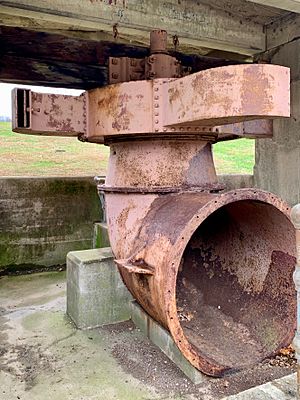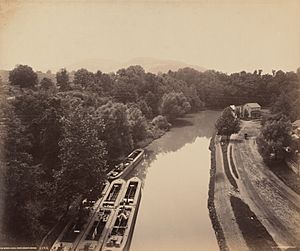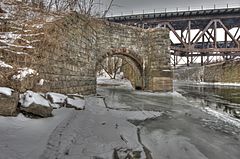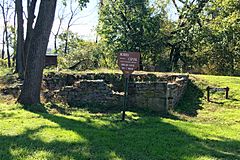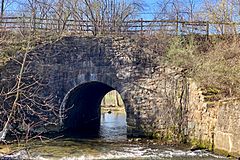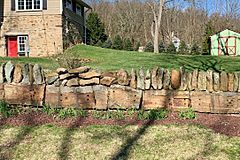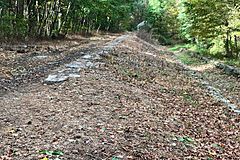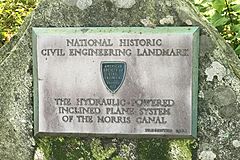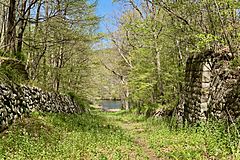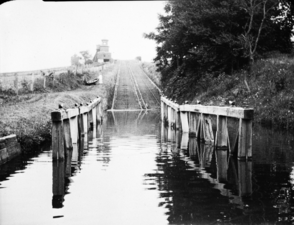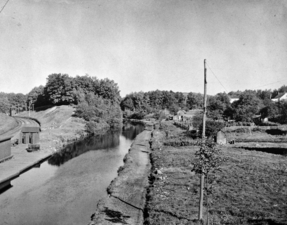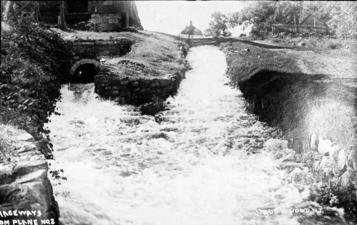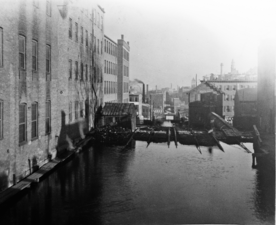Morris Canal facts for kids
Quick facts for kids Morris Canal |
|
|---|---|
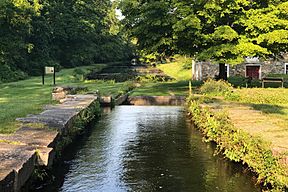
Lock 3 West at Waterloo Village
|
|
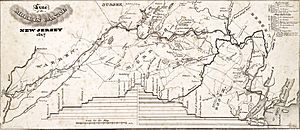
1827 Map of the canal
|
|
| Specifications | |
| Length | 107 miles (172 km) |
| Maximum boat length | 87 ft 6 in (26.67 m) |
| Maximum boat beam | 10 ft 6 in (3.20 m) |
| Locks | 23 locks + 23 inclined planes |
| Maximum height above sea level | 914 ft (279 m) |
| Status | Closed |
| History | |
| Original owner | Morris Canal and Banking Company |
| Principal engineer | Ephraim Beach |
| Other engineer(s) | James Renwick, David Bates Douglass |
| Date of act | December 31, 1824 |
| Construction began | 1825 |
| Date of first use | 1829 |
| Date completed | May 20, 1832 |
| Date closed | 1924 |
| Geography | |
| Start point | Phillipsburg, NJ (Cable Ferry connected across the Delaware to the Lehigh and Delaware Canal's river gate lock.) |
| End point | Jersey City, NJ (originally Newark, NJ) |
| Connects to | Lehigh Canal |
|
Morris Canal
|
|
| Location | Irregular line beginning at Phillipsburg and ending at Jersey City |
| NRHP reference No. | 74002228 |
| Added to NRHP | October 1, 1974 |
The Morris Canal was a special waterway in northern New Jersey. It operated from 1829 to 1924. This canal was 107-mile (172 km) long. It connected the coal fields of Pennsylvania to the big cities of New Jersey and New York City.
The canal helped move a lot of coal and other goods. It linked Easton, Pennsylvania, to places like Newark and Jersey City, New Jersey. From Jersey City, boats could reach New York Harbor.
What made the Morris Canal amazing was its technology. It had to cross hills with a total height change of over 900 feet (270 m). To do this, engineers used inclined planes. These were like water-powered ramps that lifted boats up and down hills. They were the first of their kind in the United States.
The canal was built mainly to bring coal to growing cities. These cities needed coal for their factories and homes. They had already used up most of their wood. The canal also helped New Jersey's iron industry get coal. It even moved iron ore to Pennsylvania.
The Morris Canal was very busy through the 1860s. But then, railroads became more popular. Trains could move goods much faster than canal boats. In 1871, a railroad company took over the canal. By the early 1900s, fewer and fewer boats used it. The state of New Jersey took control in 1923 and closed it in 1924.
Most of the canal was taken apart after it closed. But some parts are still preserved today. There are plans to create a walking and biking path, called a greenway, along its old route. The canal is recognized as an important historical site. It was added to the National Register of Historic Places in 1974.
Contents
How the Canal Worked
The Morris Canal started in Phillipsburg, New Jersey, on the Delaware River. From there, boats could cross to Easton, Pennsylvania. They could even go further up the Lehigh Canal to get coal.
From Phillipsburg, the canal went east. It followed the Musconetcong River to Lake Hopatcong. This is New Jersey's largest lake. From the lake, the canal went downhill. It passed through towns like Boonton and Newark. Finally, it reached the Hudson River in Jersey City, New Jersey.
The canal was 107 mi (172 km) long. It had to climb 760 ft (230 m) from Phillipsburg to Lake Hopatcong. Then it dropped 914 ft (279 m) down to the ocean. This huge height change was a big challenge. Engineers used 23 locks and 23 inclined planes to do it.
Inclined Planes: Boat Elevators
Inclined planes were special railways. They carried canal boats in large cradles. Water-powered winches pulled the cradles up and down the hills. These planes saved time and water compared to using many locks.
The planes had tracks that went into the water at both ends. A big cradle would roll onto the tracks. It would carry the boat up or down the slope. Early planes used large waterwheels for power. Later, more powerful water turbines were used.
One of the longest planes was Plane 9 West. It was 1,510 feet (460 m) long. It lifted boats 100 feet (30 m) in just 12 minutes. A loaded boat and its cradle could weigh up to 125 long tons (127 t). The turbines were very strong. They could pull boats up steep hills.
An English visitor named Fanny Trollope wrote about the canal in 1832. She was very impressed. She said the canal was an "extraordinary work." She noted how it changed levels by 1,600 feet. She also mentioned how it crossed rivers on high bridges.
Water Bridges: Aqueducts
The canal also needed aqueducts. These were like bridges that carried the canal's water and boats over rivers. One important aqueduct was over the Passaic River. Another was the 236-foot (72 m) Pompton River Aqueduct. Some old aqueducts are still around today. One is used as a road bridge.
Building the Canal
The idea for the Morris Canal came from Morristown businessman George P. MacCulloch. He thought of it while visiting Lake Hopatcong. In 1822, he gathered people to discuss the plan.
The New Jersey Legislature formed a committee. They studied if the canal was possible. They also tried to figure out its route and cost. In 1824, a company was created to build the canal. It was called the Morris Canal and Banking Company.
Construction Begins
Construction started in 1824 in Newark. The canal was designed to be 31 feet (9.4 m) wide and 4 feet (1.2 m) deep. It began at Upper Newark Bay. It followed the Passaic River, then went to Boonton, Dover, and Lake Hopatcong. Finally, it reached Phillipsburg.
On October 15, 1825, work began at Lake Hopatcong. By 1829, some parts of the canal were ready. In 1830, a 38-mile (61 km) section opened. This part went from Newark to Rockaway.
The canal officially opened on May 20, 1832. The first boat to travel the whole canal was named Walk-on-Water. Two boats carrying coal followed it. This first section cost over $2 million to build.
Life on the Canal
Soon after it opened, the canal was made bigger. It was also extended to Jersey City. Early boats were small, carrying only 18 tons. But by 1840, the canal and its locks were enlarged. Boats could then carry up to 70 tons. The boats were often split into two parts. This made them easier to move on the inclined planes.
The original canal company had problems in 1841. But it was reorganized in 1844. Improvements were made. Leaks were fixed, and new water sources were added. The inclined planes were rebuilt with strong wire cables.
Traffic on the canal reached its highest point in 1866. That year, it carried almost 900,000 tons of goods. This was like 13,000 boatloads! Between 1848 and 1860, the old waterwheels were replaced. New, more powerful water turbines were installed.
What the Canal Carried
The Morris Canal mainly carried coal, iron, and iron ore. But it also moved many other things. These included grain, wood, cider, beer, and whiskey. It carried bricks, hay, hides, sugar, and lumber too. Sometimes, boats even offered "Cool summer rides" with ice shipments.
In 1880, the canal moved about 108,000 tons of iron ore. This was from the Ogden Mine. But soon, new sources of iron ore were found. This made the canal's iron trade decline.
Busy Days on the Canal
The people who worked on the canal were very busy. A plane tender (who operated an inclined plane) said boats would line up at night. They would start moving boats around 4 a.m. They worked all day until 10 p.m. Sometimes, boatmen would go through, unload their cargo, and return all in one day.
Why the Canal Closed
The canal started losing money because of railroads. Trains could deliver goods in five hours. The same trip took four days by canal boat. This made railroads much more popular.
In 1871, the Lehigh Valley Railroad leased the canal. They wanted the land it was on. But the railroad never made money from operating the canal.
By the early 1900s, very few boats used the canal. In 1912, a study suggested closing it. The study said that parts of the canal were like an "open sewer." But it also noted that other parts could be great for parks. Many old photos of the canal were taken during these studies. People wanted to remember it before it was gone.
In 1923, the state of New Jersey took over the canal. They closed it the next year. Over the next five years, much of the canal was taken apart. The water was drained. Banks were cut. Some parts, like the Little Falls aqueduct, were even destroyed. Today, the Newark Light Rail uses part of the old canal route.
The Canal Today
The Morris Canal is now a historic district. It was added to the New Jersey Register of Historic Places in 1973. It was also named a National Historic Civil Engineering Landmark in 1980.
Some parts of the canal are still preserved. Waterloo Village is a restored canal town. You can see the remains of an inclined plane there. There's also a watered section of the canal and a canal museum.
Other parts of the canal can be found along its old path. In Kearny, New Jersey, some bridges are extra long. This is because they used to cross both the highway and the canal. The place where the canal met the Hudson River is now part of Liberty State Park.
Morris Canal Greenway
There are plans to create the Morris Canal Greenway. This will be a series of parks and paths. They will follow parts of the old canal route. It will be a great place for walking and biking.
Parks along the greenway include:
- Peckman Preserve
- Pompton Aquatic Park
- Wayne Township Riverside Park
- A walking path in Lincoln Park
Gallery
-
Delaware River Portal, canal entrance, Phillipsburg
-
Lock 3 West, Waterloo Village
-
Aqueduct over the Pohatcong Creek by Inclined Plane 7 West, Bowerstown
-
Remains of Inclined Plane 2 East near Ledgewood
Historic Images
-
Inclined Plane 12 East, in Newark. This is the third double-tracked plane.
-
Lift bridge at Grove Street in Jersey City.


